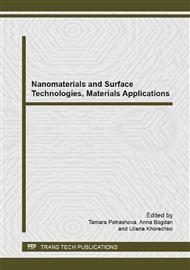p.9
p.17
p.23
p.29
p.35
p.39
p.45
p.51
p.59
The Influence of Parameters of Microarc Oxidation on the Surface Roughness and Wettability of Calciumphosphate Coatings
Abstract:
The influence of the voltage of micro-arc oxidation on the physicochemical properties of the calciumphosphate coatings has been investigated. The linear growth of the roughness and hyperbolic decrease of the surface energy with growth of the oxidation voltage have been revealed. It was shown that the calciumphosphate coatings have low contact angle and high surface energy and, as a consequence, are hydrophilic. The optimal voltage range of the oxidation has been found. It varies from 200 to 250 V. This range provides the coating formation with the following specified parameters: surface roughness of 2 – 3.5 µm; contact angles with water and glycerol of 18 - 25º and 35 - 45º, respectively, and free surface energy of 73 - 80 mN/m.
Info:
Periodical:
Pages:
35-38
Citation:
Online since:
April 2015
Price:
Сopyright:
© 2015 Trans Tech Publications Ltd. All Rights Reserved
Share:
Citation:


